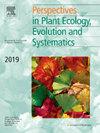Disentangling the role of fire, soil, and landscape effects on arrested succession in the Brazilian Atlantic Forest
IF 2.9
3区 环境科学与生态学
Q1 ECOLOGY
Perspectives in Plant Ecology Evolution and Systematics
Pub Date : 2025-09-08
DOI:10.1016/j.ppees.2025.125899
引用次数: 0
Abstract
Although secondary tropical forests may reach similar species richness and vegetation structure as old-growth forests in 50 years, there are situations in which they remain stagnant for decades. These divergent successional pathways vary depending on disturbance event, landscape context, land-use history and soil conditions. In the present study, we evaluated the effect of these factors in the establishment and maintenance of monodominant secondary forests of Moquiniastrum polymorphum (Less.) G. Sancho in abandoned farmlands in the Brazilian Atlantic Forest. We tested whether 1) fire history was the most significant factor associated with the occurrence of M. polymorphum forests (MPF) in the landscape; and 2) soil conditions and fire history had a determining influence on the vegetation structure, richness, and species composition of MPF. At the landscape scale, we assessed if the occurrence of MPF, comprising land cover changes between 1985 and 2020, was associated with fire events and other biophysical factors in the region. At the local scale, we evaluated the role of soil properties, fire events, and landscape context on the tree species richness, structure and floristic composition. MPF were observed further from the drainage and on slopes more affected by fires. Their coverage increased by 54 % on abandoned farmlands further from cities, where fire events were significantly more frequent. Fire history and soil properties were the factors that best explained the structure, diversity and floristic composition of MPF, while landscape showed relevance only to the floristic composition. We confirm that disturbance and soil conditions drive arrested succession in secondary forests in the southeastern Atlantic Forest. Our findings suggest that fire-soil-vegetation feedback mechanisms can maintain this alternative stable state in secondary tropical forests similarly to what happens in fire-prone ecosystems.
火、土壤和景观对巴西大西洋森林停滞演替的影响
虽然热带次生林可以在50年内达到与原生林相似的物种丰富度和植被结构,但也存在几十年停滞不前的情况。这些不同的演替路径因干扰事件、景观背景、土地利用历史和土壤条件而异。在本研究中,我们评价了这些因素在多形蚊单优势次生林的建立和维持中的作用。桑乔在巴西大西洋森林的废弃农田里。研究结果表明:1)火灾历史是否是影响多晶阔叶林(M. polymorphum forests, MPF)发生的最重要因素;2)土壤条件和火灾历史对MPF植被结构、丰富度和物种组成具有决定性影响。在景观尺度上,我们评估了强积金(包括1985年至2020年的土地覆盖变化)的发生是否与该地区的火灾事件和其他生物物理因素有关。在局部尺度上,我们评估了土壤性质、火灾事件和景观背景对树种丰富度、结构和区系组成的影响。强积金分布在离排水渠较远的地方,以及受火灾影响较严重的斜坡。在远离城市的废弃农田,它们的覆盖率增加了54. %,那里的火灾事件明显更频繁。火灾历史和土壤性质是最能解释MPF结构、多样性和区系组成的因子,而景观仅与区系组成相关。我们证实了干扰和土壤条件是东南大西洋森林次生林演替受阻的驱动因素。我们的研究结果表明,火-土壤-植被反馈机制可以在热带次生林中维持这种替代稳定状态,类似于在火灾易发生态系统中发生的情况。
本文章由计算机程序翻译,如有差异,请以英文原文为准。
求助全文
约1分钟内获得全文
求助全文
来源期刊
CiteScore
6.50
自引率
0.00%
发文量
28
审稿时长
67 days
期刊介绍:
Perspectives in Plant Ecology, Evolution and Systematics (PPEES) publishes outstanding and thought-provoking articles of general interest to an international readership in the fields of plant ecology, evolution and systematics. Of particular interest are longer, in-depth articles that provide a broad understanding of key topics in the field. There are six issues per year.
The following types of article will be considered:
Full length reviews
Essay reviews
Longer research articles
Meta-analyses
Foundational methodological or empirical papers from large consortia or long-term ecological research sites (LTER).

 求助内容:
求助内容: 应助结果提醒方式:
应助结果提醒方式:


